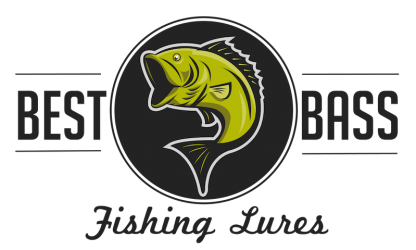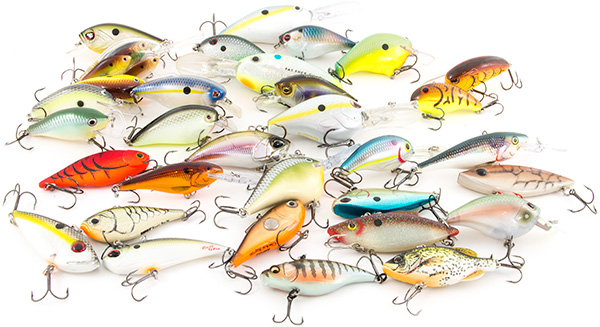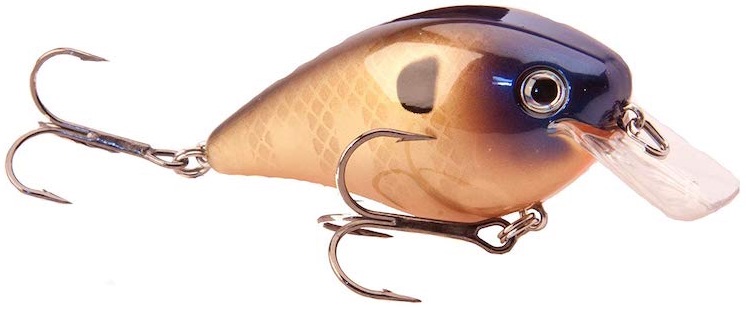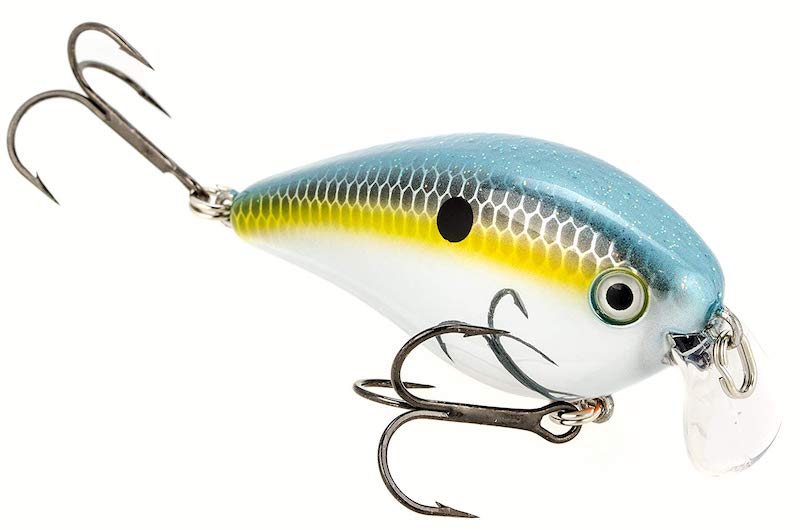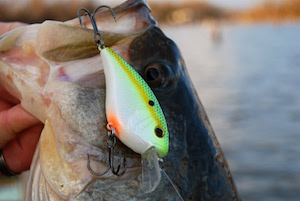Crankbaits fall under the category of power fishing lures, because of how much water you can cover with them in a short amount of time. This is a significant advantage to fishermen looking to locate and catch fish quickly, like tournament anglers for example.
Selecting the best crankbait is a more involved process than with most other bass lures. There are many factors to consider on these baits. But the most important factor is how deep do you want it to dive. Crankbaits can run from just barely below the surface to as deep as thirty-five feet.
There’s much more that goes in to the selection, and this page is going to break it all down. But if you’re just looking for a versatile crankbait that can handle most cranking situations, then check out the Strike King Square Bill.

Contents
What is a Crankbait?
A crankbait is a hard bodied lure with a rounded shape, designed to imitate the swimming action of baitfish. They have a lip (sometimes called a bill) on the face of the lure that makes it dive rapidly.
The depth at which these baits dive is based on the speed of retrieval, the size of the lip, and where the line attaches. The lip also makes the crankbait wiggle from side to side as it’s retrieved.
Types of Crankbaits
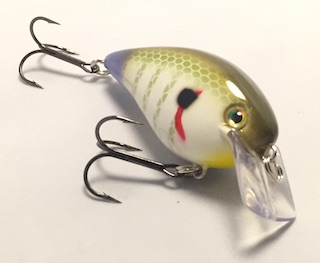
There are thousands of different types of crankbaits, but they all work the same way. They all use water resistance to make them wobble from side to side.
The most significant difference between crankbaits is the size, shape, and angle of the lip. Or if the crankbait even has a lip.
The characteristics of the lip is what determines how deep a crankbait will dive. Crankbaits are broken up by ranges of diving depths, and perform best when run at the depth range they are rated for.
So when you’re selecting a crankbait, the first thing you need to determine is what depth your targeting. They range from shallow diving crankbaits to deep diving crankbaits, with others in between.
But keep in mind that the ranges will vary from one lure manufacturer to another. One company might make a three to seven foot diver while another makes a four to six.
So there can be a gray area between crankbait classes. For example, the Strike King KVD Magnum Squarebill is rated for three to seven feet. So is it a shallow diving crankbait or a medium diving crankbait?
Crankbait classification isn’t black and white, but we still need to break them up. How else would we talk about them? We’ll start with shallow runners then dive a little deeper. 😉
Shallow Diving Crankbaits
Shallow diving crankbaits perform best in around zero to four feet of water. The lips on these models are small, and create very little resistance against the water when retrieved.
This is what keeps them running shallow while still giving them a wobbling action. The line attaches to the nose on shallow divers, which also keeps them running shallow.
Shallow diving crankbaits are ideal for working shorelines that have gradual slopes. They are the best crankbait for targeting boat docks, fallen trees, and other cover that is typically found in shallow water.
If you work them really slow you can get them to run on or just below the surface. This is a great technique when bass are active and hitting topwater. But there are crankbaits specifically designed for this technique called wakebaits.
Medium Diving Crankbaits
On mid-divers the lip is a little bigger, giving the bait more resistance in the water. The line also attaches directly to the lip on these crankbaits.
This combination of traits make them dive deeper, usually down to between five and nine feet. This depth is ideal for targeting deeper cover like rocks, sunken timber, or the tops of grass beds.
Medium divers are best used at drop offs, between shorelines and the deeper parts of the lake. They are great on sunny days when bass go a little deeper to escape the sun, or to find cooler water.
One technique that works great with medium diving crankbaits is fishing them in shallower water than the bait is rated for. You don’t want a big overlap though, one or two feet is good.
The bait will scrape along the bottom as it’s retrieved and creating an attractive disturbance. But we’ll talk more about this later when we get in to crankbait fishing.
Deep Diving Crankbaits

Deep diving crankbaits can get down as deep at thirty-five feet. These baits are a little more advanced than the shallower running models though.
When fishing in these depths, you’re most likely targeting cover or structure that you can’t see from above water. This is when having a good fish finder is useful to know what you’re fishing in.
Deep divers also require a more powerful rod that has a lot of backbone. The big lips on these baits create a ton of resistance in the water, so they need that extra pulling power.
You also need to be able to make long casts with a deep diving crankbait. These baits require a good amount of running distance to get down to their target depth. If you are not able to cast far beyond the cover you’re targeting, the bait is not going to have enough distance to get down to the targets depth before passing it.
Deep diving crankbaits work really well in the summer, when bass head for deeper water to find cool water. These are not baits that bass see in deepwater everyday so they can be very effective.
Lipless Crankbaits
Lipless crankbaits are much different looking than conventional crankbaits. Mainly because they don’t have a lip to create their action. They have a very tight wobble that is better described as a vibrating action.
Since tight wobbles are better in cold water, these are very well known for being great cold water baits. They are also excellent for fishing in grass, since they travel quickly and can be ripped through the vegetation much easier.
This page is mostly based on conventional crankbaits, but if you want more information on lipless crankbaits visit the Lipless Crankbaits page.
Selecting The Best Crankbait
If you plan to take crankbait fishing seriously, you can’t own just one and think you’re going to cover all aspects of crankbait fishing. There is no single crankbait that will do it all, but the most versatile option is a mid-to-shallow diver like the Square Bill Crankbait made by Strike King. If you want to browse a wide selection check out Bandit crankbaits.
Those crankbaits will cover three to six feet, giving you a good amount of flexibility. You can work them with a slow retrieve in the shallows around docks and other shoreline cover. Or crank them down deeper to hit submerged cover like rocks, timber, and grass beds.
But what makes crankbaits so great is the amount of customization there is in the selection process. This flexibility allows you to really zero in on the exact appearance and presentation you want. Let’s take a look at the different things to consider when choosing a crankbait.
Diving Depth
Selecting the best diving depth on a crankbait comes down to two questions. How deep is the water you’re fishing? and how deep is the cover you’re targeting? All crankbaits have their range of depths printed right on the packaging.
You hit the two extremes of the diving range by raising or lowering your rod tip during the retrieve. Keeping the rod straight out in front of you, parallel with the water, will run the crankbait in the middle of the two extremes.
Fishing line is also a big factor in how deep a crankbait will dive. The larger the diameter of the line, the more resistance it will have in the water. And the more resistance there is, the harder it is for the crankbait to get down.
The depth is also affected by the speed that you retrieve the bait. The faster you reel a crankbait, the deeper and more rapidly it dives. Slowing the retrieve down will cause the bait to raise up in the water column.
Wobble: Wide vs Tight
A crankbait’s action is referred to as it’s wobble. Some have a tight wobble and others have a wide wobble. What determines how tight or wide a crankbait wobbles is the location of the line tie.
The closer the line tie is to the body, the tighter of a wobble the bait will have. This is important to know because there are times when bass will prefer one over the other.
The best way to decide is by the water temperature. A tighter wobble tends to work better in colder water. This makes them the ideal choice for fishing in early spring and fall. During the summer months a wider, more erratic wobble tends to trigger more strikes.
Crankbaits with a wider wobble are also better in murky water. Not only is the increased movement easier for bass to see, but it also creates more vibration in the water for them to feel.
A tighter wobble is a better choice for clear water. They also deflect off cover better than crankbaits with a wider wobble. So to summarize, wide wobble for warm and murky water, tight wobble for cold and clear water.
Best Crankbait Colors
Getting your crankbait in front of bass is half the battle, it also has to have an attractive color pattern. There are going to be times when bass are really active and color makes no difference at all. The importance of color will vary from day to day and lake to lake.
On the days when color is a factor, it can literally be the difference between getting bites and getting skunked. Best practice is to always take color in to consideration.
Crankbaits come in thousands of colors. As nice as it is to have a wide selection, it can also make it difficult to decide which to use. When you’re selecting crankbait colors you should consider these three factors:
- Water Clarity: How clear or murky is the water? If you can’t see your bait in a foot of water then that is very murky water. These darker waters require brighter colors like chartreuse. In clearer water, more natural looking colors should be used.
- The Season: As the seasons change, so too do the characteristics of a body of water. This includes water clarity and water temperature. Different water temps bring about different types of prey. You’ll want to match that prey whether it be crawfish or a specific forage.
- Available Forage: Forage is the local baitfish that bass are feeding on in a body of water. You should be doing everything in your power to match your crankbait color to the color of the forage.
“To be successful, you have to fish with the color the conditions call for. You can’t fish with your favorite color all the time.”
Kevin VanDam
Best Crankbait Hooks
Getting bass hooked and staying hooked on treble hooks can be a challenge in general. So if you’re using low quality hooks you are already at a disadvantage before you even take a cast. Using good quality hooks will increase your results significantly.
The stock hooks that come on crankbaits are usually pretty low quality. They will not be nearly as sharp out of the package as a good quality hook will be. And on top of that, they will dull quickly and bend/break easily.
It’s good practice to change out your hooks everytime you buy a crankbait. One of the best crankbait hooks to use are Mustad Triple Grips. But make sure you sharpen them regularly, even good quality hooks will dull over time. Having sharp crankbait hooks at all times is essential.
Crankbait Tackle
All lures perform their best with the right equipment. But this is more true for crankbaits than most other lures. Crankbait fishermen should have at least one rod setup strictly for crankbaits. It’s generally the only rod you can’t multipurpose.
Rods
The best crankbait rod is going to be around 7 feet long with medium or medium-heavy power. Rods with these power ratings have the power to crank the baits down against the waters resistance. Lean more towards medium power for shallow divers and medium-heavy power for deep divers.
The rod should have a moderate tip. The soft tip allows the lure more freedom of movement during the retrieve. This will ensure the crankbait is performing the way it’s supposed to.
But even more importantly, the moderate action tip works very well with the treble hooks on a crankbait. It will keep you from ripping the crankbait out a bass’s mouth during the hook set. The softer flex also helps keep the fish from coming unhooked.
For more info visit the Crankbait Rods page.
Reels
Most crankbait fishing is done with baitcasting reels. Preferably a baitcaster with a fast gear ratio, like a 6:1, to give you the option of a fast or slow retrieve without sacrificing cranking power.
The only time you will see someone using spinning gear is when they are fishing small crankbaits. Spinning reels just don’t have the torque power to get mid-size or big crankbaits baits down the way that a baitcaster does.
Line
The best line for crankbaits is fluorocarbon, in the eight to twelve pound test range. Fluoro sinks so it helps the bait dive deeper than other lines would. Monofilament floats and braid tends to suspend.
Fluorocarbon also has the right amount of stretch for a crankbait rod with a moderate action tip. Monofilament would put too much stretch between the rod and the bait, and braid has almost no stretch at all.
You can control the diving depth of crankbait with the pound test line that you use. The lighter the line used the deeper the bait will be able to dive. The heavier the line gets the more it keeps the bait from diving because it has more resistance in the water.
Crankbait Fishing
You fish a crankbait the way you should fish all power fishing lures, aggressively. This is a style of fishing that involves making a lot of casts and covering a lot of water quickly.
This is what makes crankbaits such great lures for bass tournaments, when time is of the essence. You can roll up on a form of cover and bombard it with multiple casts from different angles much faster than you could with a lot of other bass lures.
Crankbaits are designed to resemble shad and other bait fish. So using a crankbait with similar colors to the bait fish in the lake you’re fishing can be very effective. Especially when bass are actively feeding on them.
How To Fish A Crankbait
The most popular way to fish a crankbait is to simply reel it in a straight retrieve. The key though, is getting the bait down to the optimal depth by reeling faster in the beginning. A crankbait will perform best when run at the depth it’s rated for.
To put the crankbait in the zone you’re targeting, you also need to overshoot the target with your cast. This is so the bait reaches the depth of the target by the time it gets there longitudinally during the retrieve. It’s also important to keep your rod tip low, this helps the lure dive deeper faster.
A straight retrieve will certainly get bites, and it should be the first technique that you try. But if you’re not getting bites, don’t assume you can’t catch bass on crankbaits that day.
Trying different retrieve methods can help get bites when the bass don’t seem to be reacting to the repetitive motion of a straight retrieve. Here are some different tactics to use with crankbait to mix things up.
Sudden Reaction Bites
If you find yourself not getting bites with a straight retrieve, try jerking your rod periodically during the retrieve. This can trigger what is called a reaction bite. It’s when a bass reacts to a sudden change in movement by attacking it.
Other ways to do this is by randomly speeding up or slowing down the bait. Or just suddenly stopping the bait during the retrieve. After a short pause, resume reeling the bait in again. Sometimes a bass in pursuit will strike when the bait suddenly comes to a halt.
Deflecting Off Cover
Getting your crankbait to crash into underwater objects works incredibly well at triggering reaction bites. When a crankbait deflects off a rock or timber it sends the bait off course. This erratic movement can be just the thing to trigger a bite.
You might think this would get a crankbait hung up, but the head-down swimming action does a good job of preventing that. The lip of hits the object and kicks the bait and hooks out of the way. Also keep in mind that crankbaits with a tighter wobble tend to deflect better.
Ticking the Grass
While not completely weedless, the lip on a crankbait can also clear the way of light vegetation. This allows you to use a technique the pros call ticking the grass.
This is when you run a crankbait across the top a grass beds. You want the bait to just be hitting the tips of the grass blades. Bass use grass beds as an ambush point, and this technique can be very effective at luring bass out to attack.
Scraping The Bottom
This is a really popular, and highly effective technique. But it can only be done on hard or sandy bottoms. If the bottom is soft or mucky the crankbait won’t be able to perform this presentation.
It’s done by using a crankbait that is rated for deeper water than the water you are fishing. The crankbait will hit the bottom and allow the lip to dig in to it. But don’t over do it, you only want the bait’s maximum depth rating to be a foot or two deeper than the actual depth.
As the crankbait scrapes along the bottom, the lip will dig and deflect off it repeatedly throughout the retrieve. Making noise and stirring up the bottom like this creates a very attractive sight and sound to surrounding bass.
